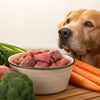How Much Does It Cost to Feed Raw Dog Food? A Detailed Breakdown
- Houndsy
Table of Contents
- Introduction
- Understanding Daily Feeding Amounts
- Determining Weekly Ingredient Needs
- Calculate Monthly Estimates
- Factors Influencing Raw Feeding Costs
- Quick Tips for Managing Raw Feeding Costs
- Conclusion
Introduction
Picture this: your dog eagerly waits for mealtime, tail wagging excitedly, eyes sparkling with anticipation. As pet owners, we all wish to provide the best for our furry friends, and one of the growing trends in dog nutrition is raw feeding. But a common question lingers in many dog owners' minds—how much does it cost to feed raw dog food?
Understanding the financial commitment of a raw diet is essential for ensuring that our beloved pets thrive without straining our wallets. With more pet parents considering raw diets, it's crucial to unpack this topic thoroughly. In this blog post, we’ll explore the nuances of raw feeding costs, from daily portions to ingredient sourcing. By the end, we’ll help you gauge how much it will really cost to feed your canine companion a raw diet and give tips to streamline the process.
So, what can you expect from this article? We will cover daily feeding amounts, the breakdown of weekly and monthly costs, the different factors influencing these expenses, and how to create a balanced raw feeding plan that fits your budget. We invite you to reflect on your own pet feeding habits as we guide you through this comprehensive overview.
Let’s dive into the world of raw dog food and uncover the costs involved, ensuring that feeding your dog becomes as enjoyable and stress-free as possible.
Understanding Daily Feeding Amounts
The foundation for estimating the cost of raw dog food begins with understanding how much food your dog needs each day. This amount will vary based on a few key factors:
-
Dog Size and Weight: Depending on whether you have a tiny Chihuahua or a massive Great Dane, the daily food requirement will differ significantly. A general guideline suggests that an adult dog should eat approximately 2-3% of their body weight in raw food. For example, a 50-pound dog would need about 1 to 1.5 pounds of food daily.
-
Activity Level: Active dogs require more calories and, thus more food than their sedentary counterparts. While a typical resting state guideline suggests around 2% for inactive dogs, active ones may need between 3-5% of their body weight. This adjustment keeps your dog healthy and energetic, adjusting the raw food intake as necessary.
-
Maintenance Percentage Calculations: To calculate the maintenance percentage, we can use the following formula:
- Daily Intake = (Dog’s Weight in lbs) x (0.025 to 0.03). For instance, if your dog weighs 30 lbs:
- Daily Intake = 30 x 0.025 (or 0.03) = 0.75 to 0.9 lbs of food daily.
This straightforward calculation will lay the groundwork for planning your dog’s diet.
Example Calculation
Let’s say your dog weighs 40 lbs. Using the maintenance percentage calculation, here’s an example:
- 0.025 (2.5%) x 40 lbs = 1 lb of raw food daily.
- Weekly, that adds up to 7 lbs, and over a month, it amounts to 30 lbs of food.
Summary
Understanding your dog's daily feeding amount is critical for both their health and your budgeting. This foundational knowledge sets the stage for estimating costs more accurately.
Determining Weekly Ingredient Needs
Having established the daily food intake, the next step is calculating weekly ingredient needs. This involves determining how much meat, bones, and organic supplements you’ll need to prepare your dog’s meals for a week.
Weekly Calculation
Continuing with our prior example for a 40 lb dog:
- 1 lb of food daily x 7 days = 7 lbs per week.
To make meal prep manageable, listing the ingredients for the weekly intake is ideal.
Example Ingredient List
Let’s look at ingredients often included in a raw dog diet:
- Meat (like chicken, beef, lamb): 70-80% of the total diet.
- Bone (for calcium): 10-15%.
- Organ meat (like liver): 5-10%.
- Vegetables and supplements (like salmon oil, berries): 5-15% of the diet.
Each ingredient can vary in cost and may require you to adjust your budget accordingly.
Summary
By determining the weekly ingredient needs, we can estimate costs more effectively while ensuring a well-balanced raw diet for our pets.
Calculate Monthly Estimates
Once we establish the daily intake and weekly ingredient needs, we can easily extrapolate this data to a monthly budget. Let’s delve into the numbers.
Monthly Requirement Calculation
Using our constant of 1 lb per day for our 40 lb dog:
- 30 lbs for a month is the number we need.
With a general average cost for raw dog food typically falling around $2.50 to $3.00 per pound, we can calculate the monthly cost as follows:
- 30 lbs x $2.50 = $75/month.
- 30 lbs x $3.00 = $90/month.
Based on these calculations, you’re looking at $75 to $90 per month just for meat.
Costs of Supplements
In addition to raw meat and bones, many pet owners choose to include variety and nutrition through supplements:
- Omega fatty acids, vitamins, and minerals should be considered too, adding anywhere from $20 to $40 monthly.
Total Estimate Breakdown
Combining the averages:
- Dog Food = $75 to $90/month
- Supplements = $20 to $40/month
- Overall Monthly Cost = $95 to $130/month
Summary
The total monthly estimate breakdown gives pet owners clarity on what to expect financially when transitioning to a raw diet.
Factors Influencing Raw Feeding Costs
Several external factors will affect costs significantly, ranging from location to sourcing ease. Here’s what to consider:
1. Location & Resource Availability
Different areas have diverse access to ingredients. For instance, meat prices vary widely based on:
- Regional cost of living.
- Local access to farmers’ markets or specialty pet shops.
Some locations may offer more affordable options if you keep a lookout for sales or develop relationships with local butchers for sourcing.
2. Investing Time vs. Convenience
- Time Investing: Sourcing deals or buying in bulk from butchers or wholesalers may initially require more time, yet can yield lower costs.
- Convenience Spending: For those who prefer pre-made foods or packed supplements, this convenience often comes at a higher price. Companies like We Feed Raw offer subscription services, yet their costs can amount to $115-$200/month, considerably more than DIY efforts.
3. Commercial Brands vs. DIY Raw Feeding
Understanding the price points between commercial raw vs. homemade diets is critical in determining monthly budgets:
- Commercial Food: Typically ranges from $4 to $7 per pound, delivering convenience and a balanced nutritional profile.
- DIY Raw: The cost may fall between $2 to $3 per pound, but requires time and research to ensure a balanced diet.
Summary
Awareness of these influencing factors is essential in planning a sustainable raw feeding budget that fits your lifestyle.
Quick Tips for Managing Raw Feeding Costs
Managing raw feeding costs effectively requires a strategic approach. Here are some practical tips:
- Buy in Bulk: Purchase large quantities when on sale or seasonally available to reduce per-pound costs.
- Join a Co-op: Pool resources with other pet owners to collectively reduce prices for bulk purchasing.
- Utilize Frozen and Canned Options: Often cheaper, these options still provide quality nutrition without the hefty price.
- Explore Less Conventional Proteins: Meats like chicken feet, tripe, and organ meats can sometimes be more affordable and offer balanced nutrition.
- Monitor Prices: Regularly check local suppliers and grocery sales for fluctuations in prices to make smarter purchasing decisions.
Summary
These tips will help ensure that feeding your dog a raw diet doesn’t become an overwhelming financial burden, letting you focus on the joys of pet ownership instead.
Conclusion
Feeding a raw diet to our dogs is an investment not just in their health but also in the quality of life they experience. While costs may initially seem higher compared to traditional kibble, the benefits of high-quality nutrition often outweigh the expense. We hope this comprehensive breakdown helps you feel more informed as you navigate the financial aspects of raw feeding.
Reflecting on your own experiences, how do you feel about the costs associated with feeding your pet a raw diet? Have you considered adopting a raw feeding style, or are you already doing so? Knowing the various factors at play and planning accordingly can make all the difference for you and your canine companion.
For those of us who want a seamless feeding experience that combines form, functionality, and style, we highly encourage you to explore the Houndsy Kibble Dispenser. This innovative product not only simplifies feeding but also ensures the feeding routine fits beautifully with modern home decor (Order Now: https://houndsy.com/products/houndsy-kibble-dispenser).
FAQ
1. How can I safely store raw dog food?
Store raw dog food in your freezer to maintain its freshness. Use airtight containers and label them to keep track of what you have and when it expires.
2. Can I combine raw food with kibble?
Yes, many pet owners choose to do so. However, it’s essential to monitor your dog’s digestive reactions and adjust portions accordingly.
3. Is raw feeding suitable for puppies?
Puppies can benefit from raw diets, but it’s crucial to control their calcium and phosphorous intake. Always consult your veterinarian before beginning a raw diet for growing puppies.
4. Do all raw diets meet AAFCO standards?
Not all raw diets are created equal. When choosing a commercial raw food, ensure it meets AAFCO standards to provide your dog with balanced nutrition.
5. What steps should I take when switching my dog to a raw diet?
Gradually introduce raw food to your dog’s diet over a week to prevent digestive upset. Monitor your dog’s response and consult with your veterinarian for tailored advice.
With this detailed insight into how much it costs to feed raw dog food, you can confidently embark on the journey of transitioning your dog to a healthier way of eating. Happy feeding!












